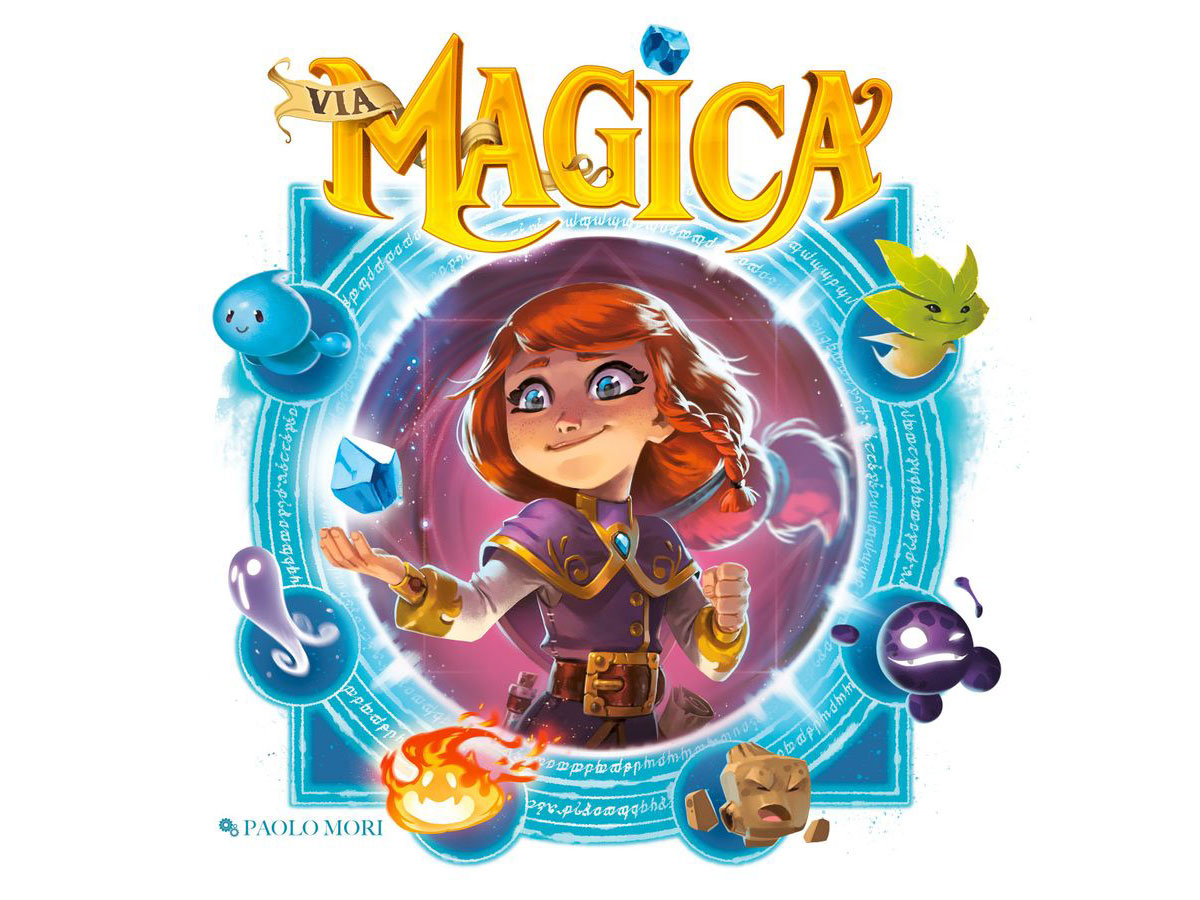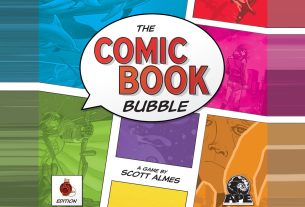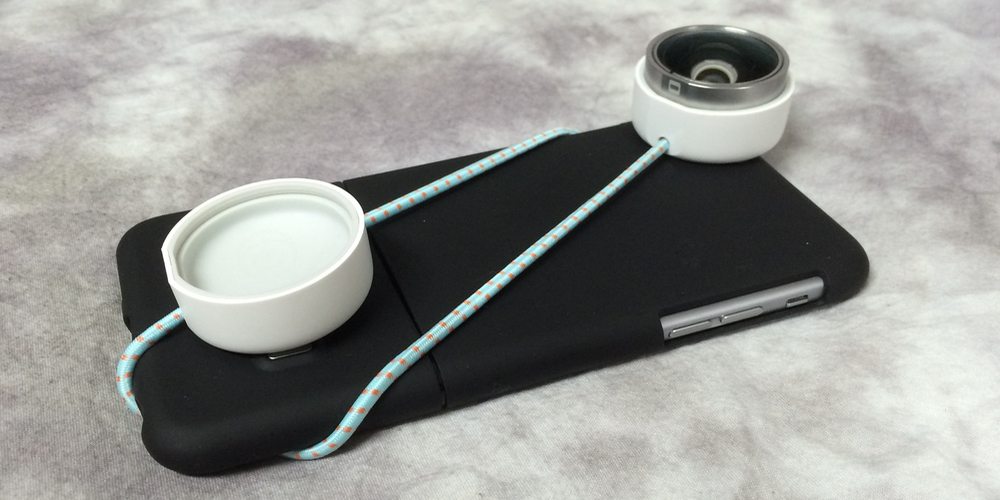It’s time for your magical exam! Use the energy from animus to open portals, paving the way to the Via Magica.
What Is Via Magica?
Via Magica is a Bingo-inspired game for 2 to 6 players, ages 7 and up, and takes about 30 minutes to play. It’s an adaptation of Rise of Augustus with a new theme and rules tweaks to make it a little more kid-friendly, but the gameplay is nearly identical. It retails for $24.99 and is available now—check with your local game stores or online retailer.
Via Magica was designed by Paolo Mori and published by Hurrican Games, with illustrations by a team of artists: Biboun, Paul Mafayon, Camille Chaussy, Jérémie Fleury, Mathieu Leysenne, Régis Torres, and Djib. Luma is the US distributor for the game.

Via Magica Components
Here’s what comes in the box:
- 23 Animus tokens
- Cloth bag
- 10 Bonus Reward cards
- 80 Magic Portal cards
- 6 Player Aid tokens
- 48 crystals

The portal and bonus cards are all large, wide cards—not as tall as tarot-sized cards, but bigger than standard poker cards. That leaves plenty of room across the top for the various elemental spaces, which seems to be the limiting factor. The point values, portal effects, and portal type are near the bottom of the card, with the bulk of the card taken up by an illustration of the portal (and what’s on the other side).
The artwork is fanciful and depicts some of the magical ingredients you’re retrieving through the portals, like troll snot or toadspit. For the most part, the icons at the bottom of the portals are fairly easy to interpret, but the back of the rulebook spells everything out in case you need help. There are four portal types, distinguished both by the color of the glow and the icon on either side of the portal; although the game is quite colorful, it shouldn’t present any difficulties for color-blind players.
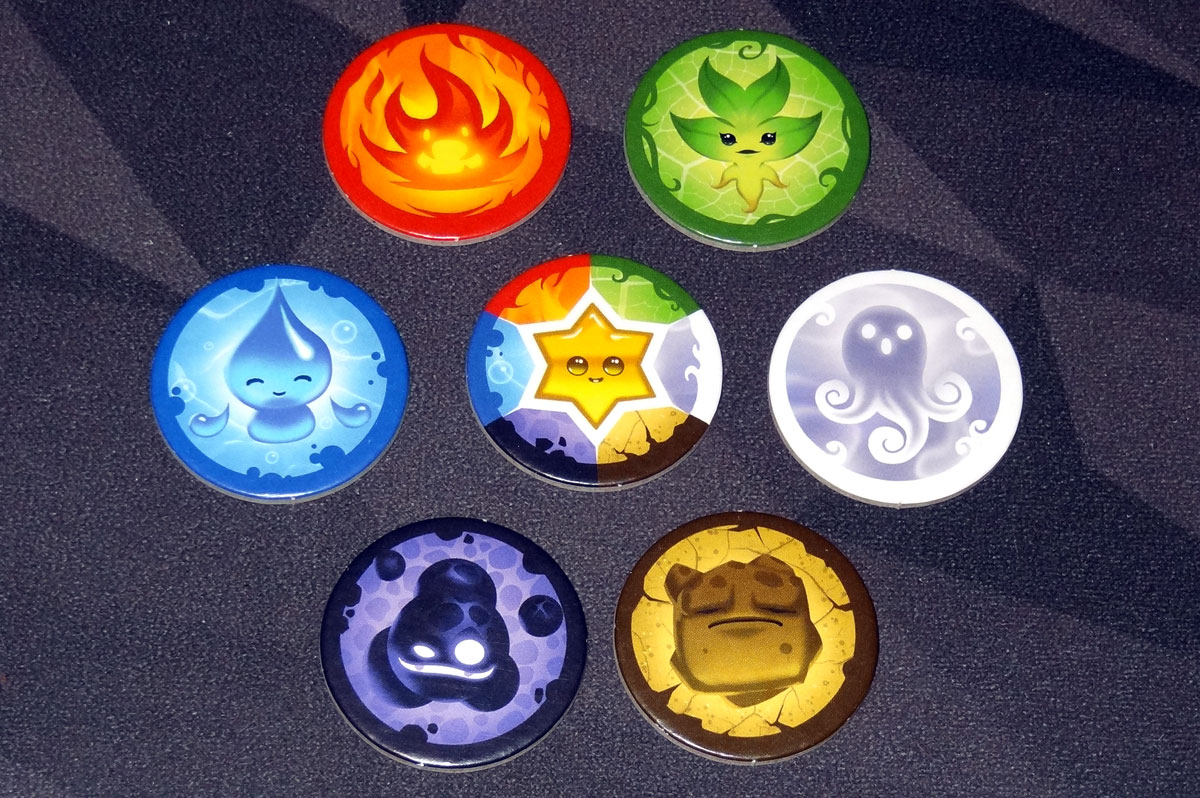
The animus tokens are cardboard discs about the size of poker chips, each depicting a different animus spirit based on these elements: air, water, earth, life, fire, and shadow, as well as some wildcards that can be used as anything. There are varying amounts of each element, so air is most plentiful and shadow is the rarest. (The player aid tokens show the different elements and how many of each chip there are.) The animus look like little living versions of the element.
The crystals are a standard small plastic crystal shape, in translucent blue.
How to Play Via Magica
The Goal
The goal of the game is to score the most points by the time any player has opened 7 portals.
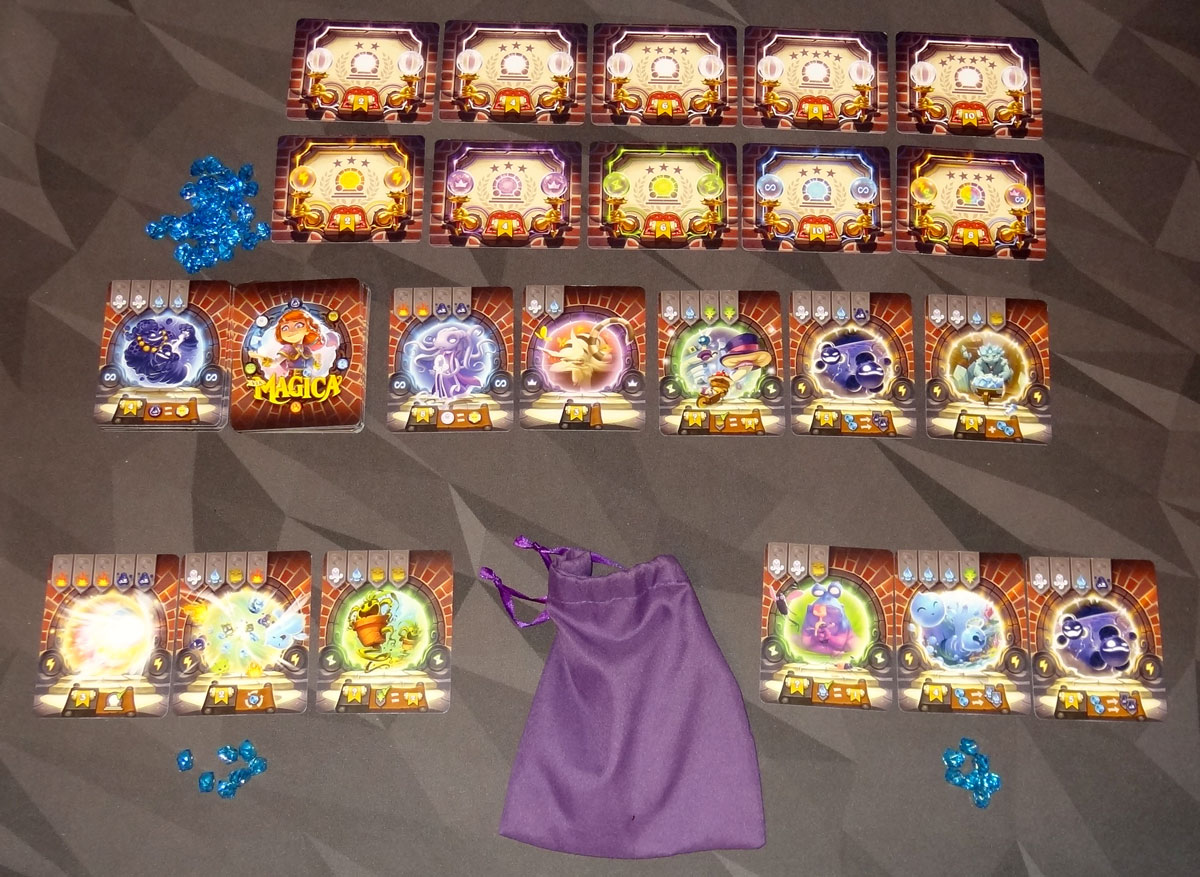
Setup
Put the animus tokens in the bag. Lay out the 10 bonus reward cards so they’re visible to everyone.
Shuffle the portal cards and reveal 5 to form a market. Deal 6 portal cards to each player; each person chooses 3 to keep (placing them face-up in front of them in a “crystallization area”) and discards the rest. (Note: you may not open two of the same portal, so there’s no reason to keep duplicates.)
Each player takes 7 crystals; set the rest nearby as a supply.

Gameplay
Players take turns being the Catcher—the one who draws an animus token from the bag. The token is announced to everyone and placed on the table where it’s visible. Every player may then place a crystal on a matching space on one of their portals. You may use a crystal from your supply, or if all of your crystals are already on your portal cards, then you may move a crystal from its space to a matching space. The animus token is then placed back into the bag, and the bag can be passed to the next player.

If you fill up all the spaces on a portal card, then you’ve opened the portal! You shout “Incantatum!” and then do the following:
- Remove the crystals and put them back in your supply.
- Use the portal’s effect if applicable.
- Slide your portal forward to your achievements area.
- Choose a new portal from the market and place it in your crystallization area.
- Refill the market from the deck.
- Claim bonus rewards.

There are two types of awards: one is based on opening a certain number of portals, and the other is based on the colors of portals. For the number of portals, you may claim the reward matching the number of portals you currently have open—but you can only claim one of these rewards, so if you open a portal and want to wait to get a better reward, then you can’t go back and claim a smaller one later. However, the reward only goes to the first person to claim it.
For the color-based rewards, you claim it if you’re the first to open the requisite set of portals, and you can claim more than one of these rewards.
At the end of the turn, the next player becomes the Catcher and draws another animus tile.
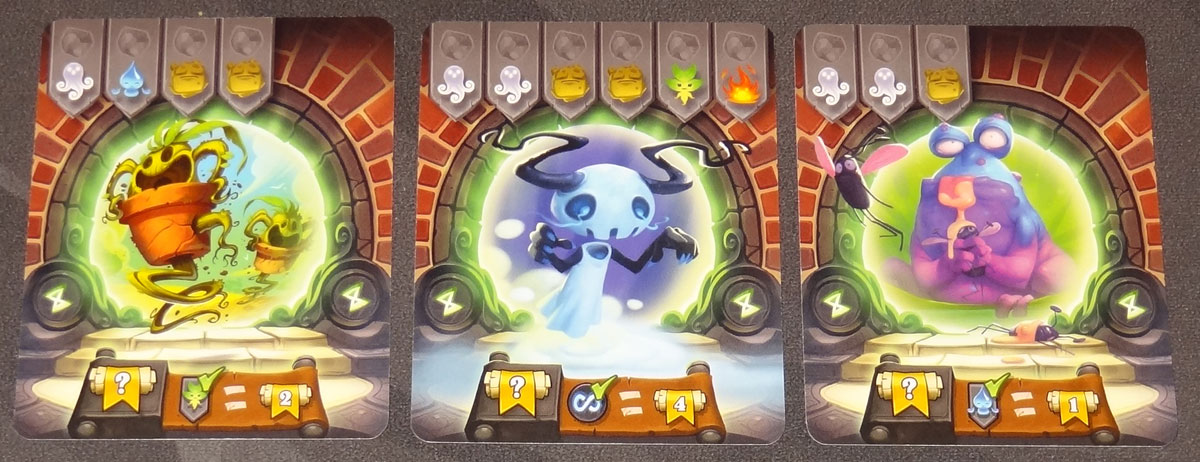
Game End
The game ends if any player has at least 7 open portals at the end of a turn—finish the turn as usual, then add up your scores. Bonus rewards have their value printed on them, as well as yellow, purple, and blue portals. Green portals have values based on what else you’ve opened—for instance, the number of fire spaces you have on your open portals, or the number of blue portals you’ve opened.
The player with the highest score wins, with ties going to the player with the most portals opened.
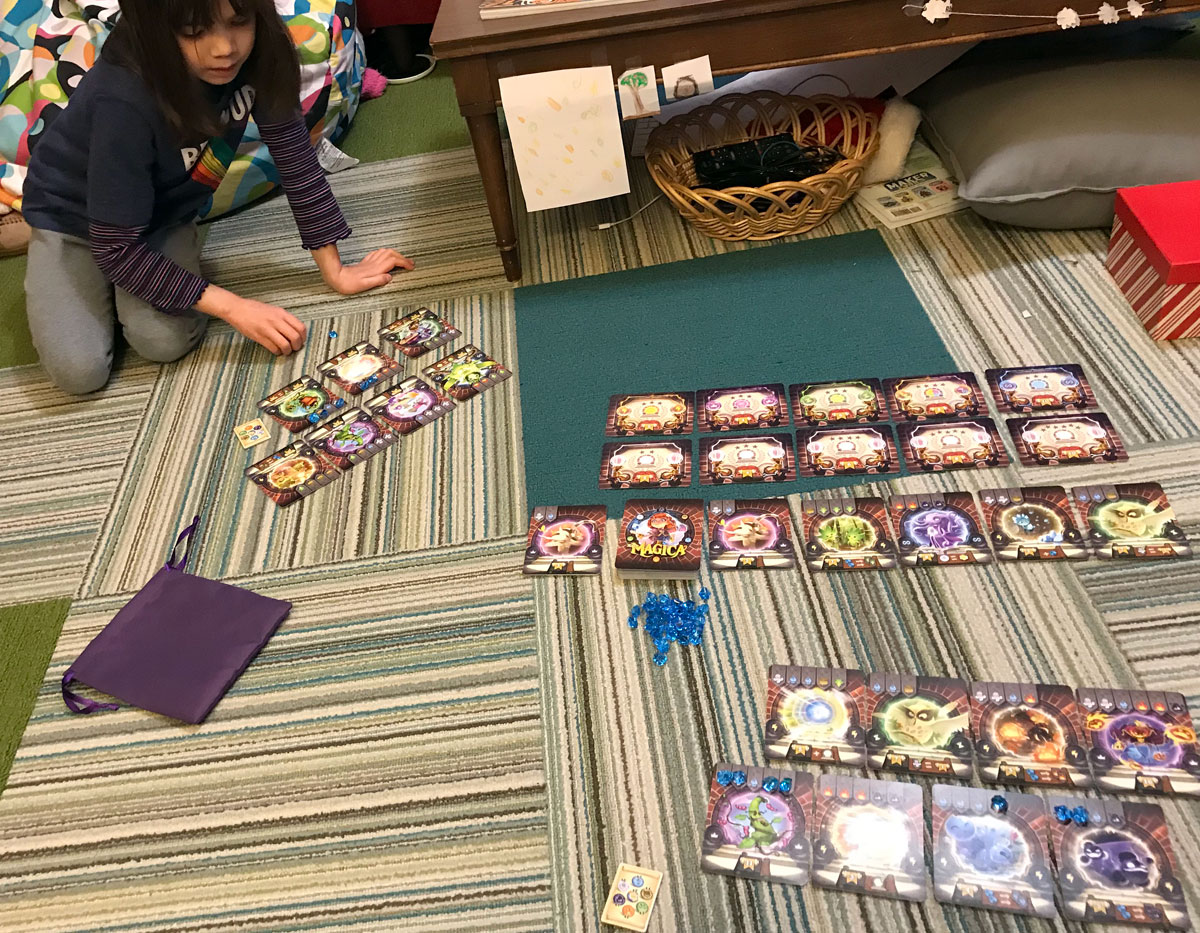
Why You Should Play Via Magica
Via Magica is a bit like playing Bingo—a token is drawn, and everyone gets to mark that space on their own cards, hoping to fill in a card so they can score points. That makes it pretty easy to learn, too: my 7-year-old picked up on it very quickly (and even beat me during our first game, as evidenced by the equation she wrote down afterward).

But there are some twists that make Via Magica a bit more engaging than Bingo, and add a bit of strategy to the luck. For one, you have some choice in which portals you take, and thus the elements needed to open them: portals that use a lot of air and water may be easier to fill, but are usually not worth as much as those that use fire and shadow. When a token is drawn, you may have multiple choices about where to put your crystal.
Another significant difference is that you only have 7 crystals. Portals can take anywhere from 4 to 6 crystals to open, which means that if you spread yourself too thin over your three portals, you’ll just run out of crystals. You need to complete one so that you get your crystals back.

I like the fact that the animus tokens are placed back into the bag every turn—in effect, it’s a bit like rolling a 23-sided die: the odds of a given element are the same every turn because the tokens aren’t exhausted. It’s a fun way to show my kids how probabilities work (and also how things can still surprise you sometimes, like when you draw more fire than air in one game).
The special effects of the portals are important to consider. Purple portals are simply worth points—usually a little more than others. Green portals are also for scoring, but are based on portals that you have opened, so you need to look for good combos. Yellow portals have immediate effects when you complete them, from letting you place some crystals immediately to getting extra crystals from the supply, or even opening another portal for free! Blue portals give you a permanent effect, making one element type wild for the rest of the game. Finding ways to combine these powers can boost your score.
Finally, there are the bonus rewards: do you try to collect 3 portals of the same color? Or 1 of each color? The game ends when somebody hits 7 portals, so it can be hard to get several of these bonuses. Plus, you’re limited by what portals show up in the market. The number-based bonuses have a press-your-luck element to them. Sure, you could get your guaranteed 2 points if you’re the first one to open 2 portals, but getting to 6 portals is worth 10 points. On the other hand, if you pass up a number reward (hoping for the next one) and then somebody beats you to it, you might get no bonus at all.

The magical theme and new artwork of Via Magica will probably be much more attractive to kids than the provinces and senators of Rise of Augustus. It plays quickly, and because everyone plays out the turn together, adding more players doesn’t significantly increase the length of the game, either. I will note, though, that because of the size of the cards and the number that may be spread around on the table, this game takes up quite a bit of space. If you have more players, you may want to put the market cards and the bonus cards in stacks instead of in rows to save room.
My daughter and I have been enjoying it, though I haven’t tried it out with my adult gamer friends because of the pandemic. Since it’s fairly light, it’s the sort of game I would probably use as an opener to warm up before teaching something a little more involved, but I also like the way that it can accommodate a broader range of skill levels.
Like Bingo, there’s not any direct player interaction: each player is just filling out their own portal cards, and your actions are pretty much independent of anyone else’s. The only interaction is indirect, when you choose portal cards from the market and the race for the bonus cards—in those instances, it may be worth checking to see what everyone else has, so you can evaluate your odds of completing a bonus or prevent another player from completing a set.
If your kids love Bingo-style games but you want something that isn’t pure chance, check out Via Magica for a cute spin on the genre!
Click here to see all our tabletop game reviews.
![]() To subscribe to GeekDad’s tabletop gaming coverage, please copy this link and add it to your RSS reader.
To subscribe to GeekDad’s tabletop gaming coverage, please copy this link and add it to your RSS reader.
Disclosure: GeekDad received a copy of this game for review purposes.
